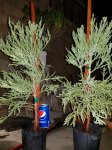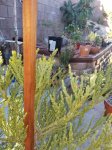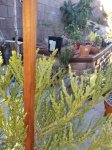theone420
Shohin
So I ordered 2 Giant Sequoia from giant-sequoia.com. They both seem healthy and I wanted to get your advise before doing any potting.
The idea is to put one in a pot and start the process of converting the roots to small container life.
The other will be put the the ground and allowed to spread out a bit more.
I understand it will be a challenge to grow these in the desert where I am(it can get up over 120F here in the summer). I do however manage to grow a lot of things I shouldn't. So I figured, why not. and I ordered the two trees before winter in order to give them a chance to experience our 50degree lows. and get ready for a long ride next summer. I think I can keep them in some shade and get some air flow with some misters and maybe get the temps down enough to help.
But........First I want to ask if they seem healthy and maybe ready for a larger pot and maybe a 2" root reduction from the bottom of the pot as suggested by .giant-sequoia.com's reference page for reducing 1gl pots for bonsai, or should that wait?
And I wanted to confirm that the yellowish-green tips is new growth.




The idea is to put one in a pot and start the process of converting the roots to small container life.
The other will be put the the ground and allowed to spread out a bit more.
I understand it will be a challenge to grow these in the desert where I am(it can get up over 120F here in the summer). I do however manage to grow a lot of things I shouldn't. So I figured, why not. and I ordered the two trees before winter in order to give them a chance to experience our 50degree lows. and get ready for a long ride next summer. I think I can keep them in some shade and get some air flow with some misters and maybe get the temps down enough to help.
But........First I want to ask if they seem healthy and maybe ready for a larger pot and maybe a 2" root reduction from the bottom of the pot as suggested by .giant-sequoia.com's reference page for reducing 1gl pots for bonsai, or should that wait?
And I wanted to confirm that the yellowish-green tips is new growth.
















